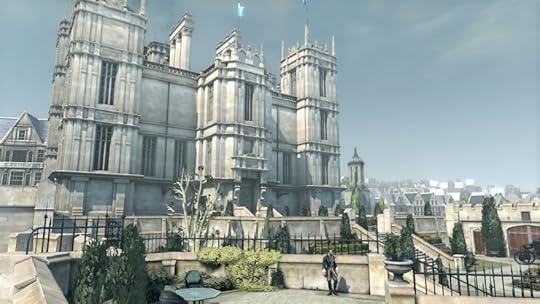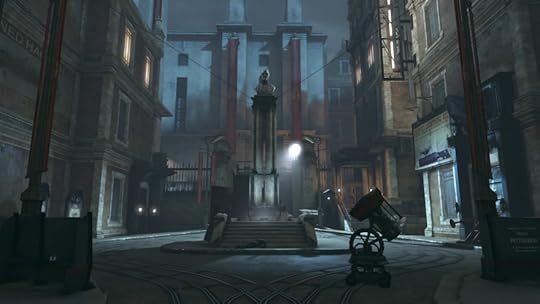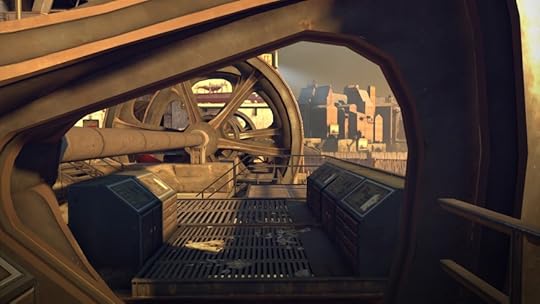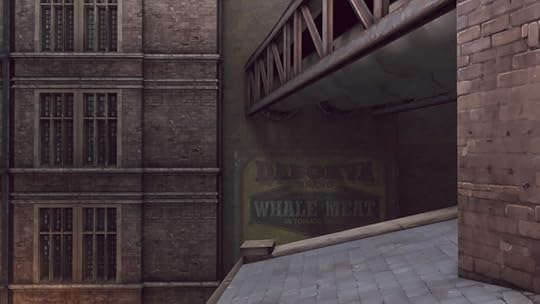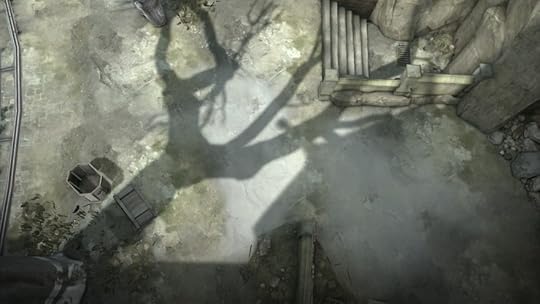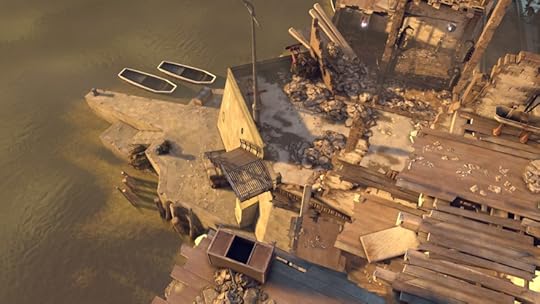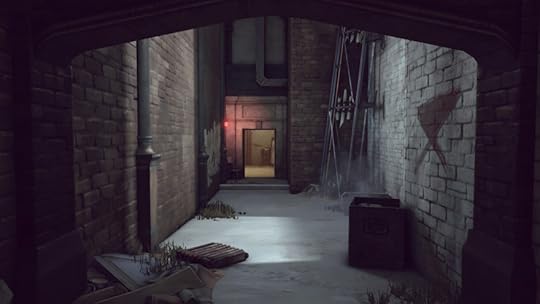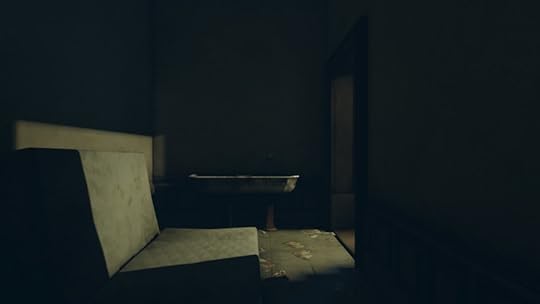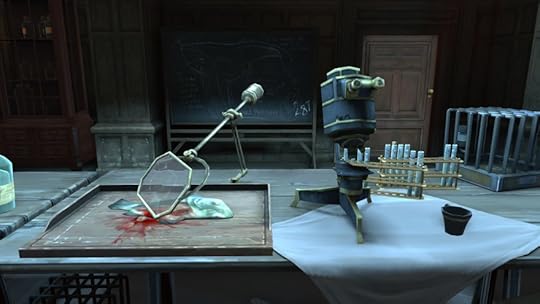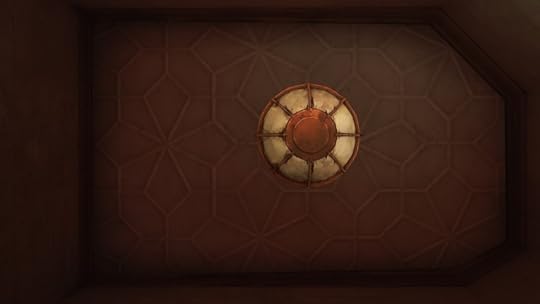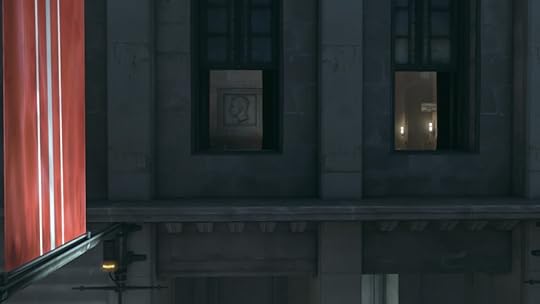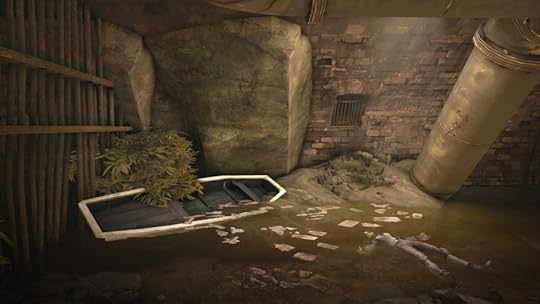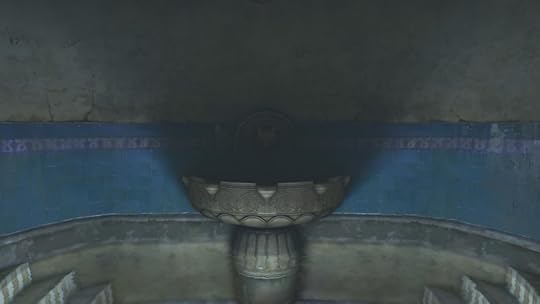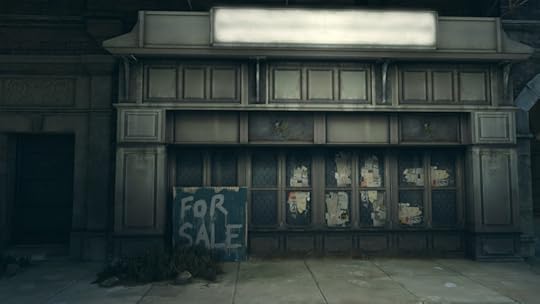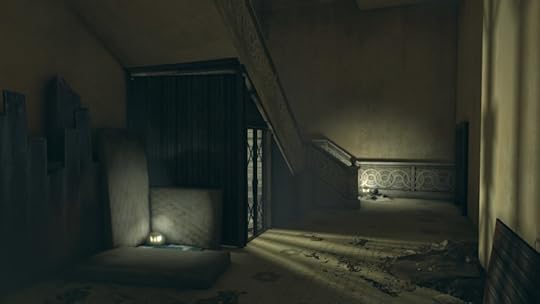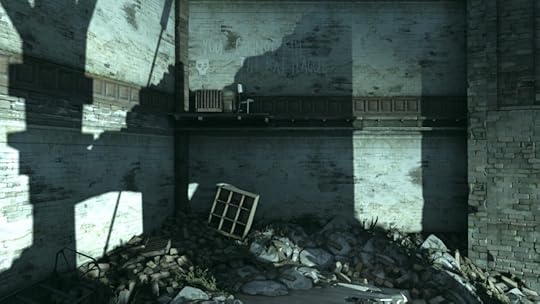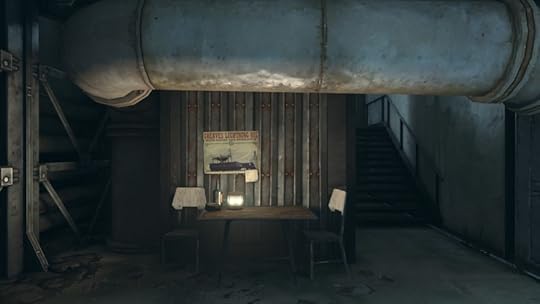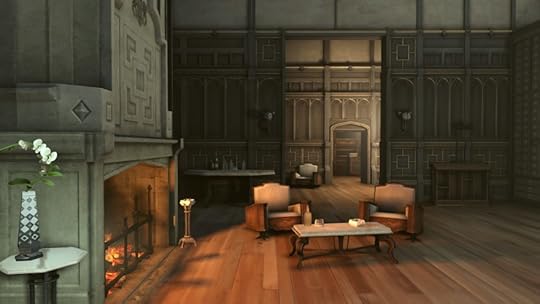Kill Screen Magazine's Blog, page 40
October 19, 2016
The perfect videogame for people into stargazing
I like to dream about space—the flowering alien plant life light years away from Earth, the planets circling a big burning star rivaling our sun. It’s water on Mars and planets made up of swirling gas that I think about, too. I’ll conjure up in my mind the planets lurking just beyond our solar system’s reach, though some day I won’t have to: in January, planetary scientists Konstantin Batygin and Mike Brown discovered evidence of what they believe is a Neptune-sized planet that orbits our sun every 15,000 years: Planet X.
Unlike me, Batygin and Brown are actually searching for new planets—perhaps to make up for Brown’s killing of Pluto—instead of just dreaming about them. Proving that Planet X exists means seeing it from a telescope, a really, really big telescope. That hasn’t happened yet, but they do have one of those telescopes in Hawaii, but the team probably won’t invite strangers over to help. So you’ll have to get your fill another way. Science-fiction videogame OPUS: The Day We Found Earth might help.

“For stargazers who enjoy heartfelt stories and arguing about Pluto,” the website reads, OPUS is a stargazing simulator. You’re not looking for new planets, though; you’re looking for Earth. Despite that, you will find a lot of new planets. (There’s an achievement for scanning 1,000 times.) In fact, that’s almost entirely what you’ll do.
Is it Earth? No. Then move on
No puzzles fill OPUS’s spaceship: just pure exploration and discovery, through searching the stars and listening to the characters tell their stories. You’ll name things, too, like planets and stars. Scan something, name something. Is it Earth? No. Then move on. OPUS is quite repetitive in that way; a good thing if you like to look at pictures of planets and name them and a bad thing if you’re looking for anything more. Its narrative is what changes and moves along, while gameplay remains almost entirely unchanged throughout the entire game. Hidden in unlockable rooms through the spaceship are little hints and clues about adorable helper robot Emeth and the ship’s mission, though you’ll likely only find them if you’re looking. And I encourage you do to just that. There’s no rush in OPUS, anyway.
Earth is waiting, but you won’t be punished if you don’t find it fast enough. Take your time. Check out the stars. Dream about what’s hiding just past Pluto and beyond.
Developed by SIGONO, OPUS: The Day We Found Earth is available on Windows and Mac for $9.
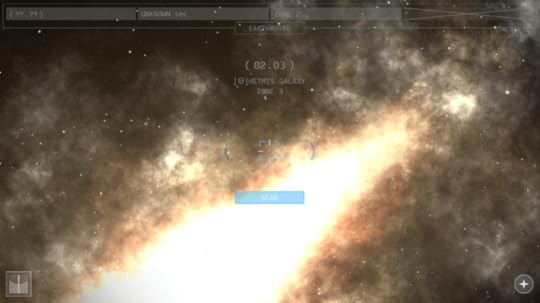


The post The perfect videogame for people into stargazing appeared first on Kill Screen.
Thoth isn’t here to make friends
Thoth works on certain illusions. A static screenshot would make you think this twin-stick shooter is more in line with Jeppe Carlsen’s previous game—the rhythm-based, minimalist platformer 140 (2013)—or that your dot in Thoth is kettled in against mean squares that look like descendants to Geometry War’s (2003) shapes. Thoth may only have a few matted colors at a time, but it is very loud; a mouse that roars.
it invokes stages of fear
Those squares, and many other bad shapes, are 3D in a 2D world. The way they float appears more like a gelatin warble, or a figure lashing around underneath a plain-colored sheet. Those hidden corners and contours can slip out and end you suddenly. The noise they make comes from your local industrial drone-art installation. Frosted wails echoing in void spaces. They cool down when your game does, and crash back at full volume in the moment things pick up. They are cut by the clatter of your spraying bullets, which sound like mad footsteps from older arcade games. In fact, there are arcade game strands throughout, homeopathic drips—the jingle between levels has a specific Dragon’s Lair (1983) ring.
Unlike Geometry Wars or Robotron (1982)—the latter being Carlsen’s chief inspiration—Thoth is not based on chasing scores, instead it invokes stages of fear. You are not attacked by endless waves of enemies before a high score screen. You can only take one hit. Checkpoints are set three stages away from each other. Each short segment pits you against aggressors that are specifically paired to make your time with the game a cruel nightmare. The most satisfying element of this structure is that you’ll often experience the thrill of being cornered, your guns-a-blazing, stuck in your last stand and coming out on top.
Usually, each of these three sets have their own twist. Enemies generally float towards you with a slow magnetic pull, but sometimes they will have a red rover chain between them that can also kill you. Sometimes the enemies are spire-shaped, and are only able to slide side-to-side like automatic doors. Projectiles from others are rare, though some enemies will spit a cube at you when defeated. Sometimes walls of spikes will close in, or activate between kills. One will inflate itself into a massive donut after one if its friends is killed.
It is decidedly ruthless
Every enemy, when defeated, isn’t immediately out of your hair. It will leave behind an imprint; a shadow form that rips a window into some starry sky, and continue to pursue you. One of the more dire enemies demands tact when facing it as it expands perpetually, but can be beaten back into itself with a few bullets. When it’s completely destroyed, it will began to expand much faster, manifesting this time as the window to the starry void that the dead become, and having already been killed cannot be contained again. Killing enemies only makes them vengeful ghosts. I feel like there’s a joke about that somewhere.
Thoth’s main addition to the twin-stick shooter is its constant intimidation tactics. The short segments you set out to beat—64 in all—keep you aghast constantly, and you’ll learn quickly that even when things look peaceful it can mean that something deadly hasn’t shown itself to you yet. Silence is just an opportunity for a bomb to go off. This isn’t a surprising revelation considering that Carlsen was the lead puzzle designer at Playdead for Limbo (2010) and Inside. One of the earliest challenges in Limbo involved a giant, razor-thin spider falling out between the shadows of the trees and striking you down. Once you know that the beasts are out there, you approach everything with a lot more caution—Thoth has similar lessons to teach.
Being cruel makes Thoth hard, but it doesn’t necessarily make it interesting. The kind of knotted dance your fingers have to do in the similar Soft Body is more dynamic, interchanging, and captures a sense of brutal intensity without completely relying on it. The rhythmic layering of Everyday Shooter (2007), another twin-stick shooter with a strong sense of audio, uses sound and music to elevate it beyond its unrepentant mood. Thoth has a two player co-op mode, but when one player dies they transform into a shape belonging to the void as well—the most vicious of them all, in fact. Thoth isn’t here to make friends. It is decidedly ruthless and daunting, a challenge with matched aesthetics, but not a whole lot more than that.
For more about Kill Screen’s ratings system and review policy, click here.
The post Thoth isn’t here to make friends appeared first on Kill Screen.
October 18, 2016
A driving game inspired by the creator’s real-life escape from the Soviet Bloc
Car games are typically shiny and chrome—vehicles dedicated to portraying their brands in the best possible showroom lights. They focus almost entirely on the image of the car you see in ads: sleek and stylish, fast, an Americanized ideal of the freedom of the open road. You rarely see them the way that Ondřej Švadlena presents them in his untitled work in progress, a moody driving simulator in which you drive down dark streets pursued by oddly physicked AI foes.
The project, whose progress has been documented in a TIG Source forum, is a large-scale open world game where you drive through hostile territory. In keeping with classic car movies of the ’70s—Vanishing Point (1971) and Duel (1971) among them—you avoid pursuit from unknown entities in your quest to cross this dead land.
an ordinary kind of odd
Švadlena, who is perhaps best known for his work in animation, takes a variety of influences to craft the almost post-apocalyptic darkness in which he sets his scene: “Definitely a significant event was our escape from, at that time, totalitarian Czechoslovakia in 1984. It was an eight hour night hike across the mountains dividing Yugoslavia and Austria, where somewhere in the middle of that journey, we were above a border crossing station where soldiers with machine-guns were searching the surroundings with floodlights accompanied by the sound of barking dogs.”
The project calls to mind that influence as the player character can stare into the rear-view mirror and catch a glimpse of their pursuers, pig-like creatures that more closely resemble Sloth from the The Goonies (1985) than any actual person. There is the impression of yellowed streetlights cast through rake-thin trees onto slick asphalt, an ordinary kind of odd. It is the normalcy of the post-apocalypse, not the “He-Man with cars” Švadlena sees as the Mad Max sequels but rather the soul of the original: “the contrast between the crazy behavior of it’s inhabitants and the setting itself, which was very ‘normal’ or ‘familiar’.”
The car, both in this dead world and in Švadlena’s personal history, takes on a new meaning from the traditional auspices of car games. It is not, in this context, a glistening vehicle by which you can effortlessly drift through gleaming Milanese streets. It is instead a method of escape and survival. “At the age of six, after spending three weeks at a clandestine boy-scouts camp … when my parents came to pick me up, the first thing I wanted to do, was just to sit in our car. An orange Dacia – the same car in which we drove to Yugoslavia, later that summer, and left it near a forest before escaping on foot to Austria.”
You can find out more about Ondřej Švadlena’s project through their TIG Source forum updates.
[image error]


The post A driving game inspired by the creator’s real-life escape from the Soviet Bloc appeared first on Kill Screen.
Videogame voice actors have had enough
After an extended series of negotiations that began in February 2015, the leading labor union representing voice talent in the United States has yet to create an equitable contract with some of videogames’ largest publishers and developers. Now, the Screen Actors Guild – American Federation of Television and Radio Artists (SAG-AFTRA) has drawn a line in the sand.
In a statement released Monday morning, SAG-AFTRA announced a strike date for all union performers, targeting 11 videogame employers—including big hitters Activision, EA, Take 2, and WB Games. The threat of strike is intended as a bargaining chip, as representatives of the union and employers come to the table for negotiations this week. If the final round of negotiations (scheduled through October 19th) does not produce a workable contract, the strike will begin on October 21st.
performers working on titles under the 11 listed studios will cease their work
SAG-AFTRA represents approximately 160,000 performers across multiple industries. They’re a massive force in entertainment, with union membership a prerequisite for any performer on the professional stage. Videogame studios that sidestep the union would find themselves unable to work with most professional performers. Actors that violate union membership could also find themselves barred from work with major studios across the entertainment landscape. If the 11 employers listed in SAG-AFTRA’s announcement fail to bring an agreeable contract to the table, any performers working on titles under the 11 listed studios will cease their work (as long as the project went into production after February 15th, 2015).
The demand that has drawn the most resistance for AFTRA has been their call for ‘secondary compensation’. This would entitle performers to a ‘reasonable bonus’ for every two million copies of a game sold (or subscriptions to online games), capped after eight million copies. Similar bonus structures are present in many other SAG-AFTRA contracts, and are seen as a justified reward for outstanding performance in the most successful titles.
Lani Minella in the studio, who has voiced over 500 videogames
Further demands pertain to employee safety, including less strenuous recording sessions—shortening difficult sessions from four to two hours—and the mandatory presence of a stunt coordinator on set for performance capture. The union believes making these changes mandatory will reduce worker injuries and bring workplace standards in line with other entertainment industries. Talks of a strike began back in 2015, after stagnant contract negotiations prompted a union-wide vote authorizing strike. The vote needed 75 percent of union members to support a strike in other to move forward. It received 96 percent support.
///
Following the public announcement of the strike date, Scott J. Witlin of law firm Barnes & Thornburg made a statement to the media on behalf of the 11 affected companies.
“The Video Game Companies had already scheduled bargaining sessions this week with SAG-AFTRA union leaders to attempt to reach a mutually beneficial agreement. We expect these negotiations to remain in place, and will continue to attempt to reach a fair and equitable contract despite the Union leadership’s most recent threatened labor action,” Witlin’s statement notes.
The statement also proclaims that SAG-AFTRA’s representation of current labor standards on their website are outdated, and exaggerate the lack of progress made on negotiations over the past 18 months. Witlin also makes note that the game companies “anticipate minimal impact on current and near-future game releases.”
The post Videogame voice actors have had enough appeared first on Kill Screen.
A short documentary about the future of women in videogames
When Laila Shabir moved to Cambridge, Massachusetts to start school at the Massachusetts Institute of Technology, her Pakistani father told her to live her life as if she were a young man—to live her life without fear, something young women around the globe aren’t always taught.
Shabir is the founder of Girls Make Games, a series of international summer camps put on by educational company LearnDistrict aimed at teaching girls the skills needed to make videogames. Camps were first introduced in the United States and later went global. Shabir discussed the organization in Girls Level Up, a recent short documentary made as part of Critical Path’s videogame culture documentary project. “It was interesting watching these American girls because they’re getting the same messages that I got as a girl growing up in the East,” Shabir said, “except the messages here are more subliminal.” Videogames are part of that.
Girls Level Up follows the girls making games during camp in Mountain View, California. But there are a lot more girls, Shabir said, that sign up for camp but drop out just before it starts: “They’re just so sure that they’re going to be bad at it because it feels like something girls don’t do.” There’s those subliminal messages again.
Shabir’s hopefulness about an accepting, diverse industry
“At school, if there’s anything, any project that has to do with a PowerPoint or electronics, all the boys would take control over,” one camper in the documentary said. In many situations, it’s assumed that these girls wouldn’t even want access, let alone be given access, when there are others who’ve prematurely been deemed more qualified.

“I started out making games to help people learn,” Shabir said, “and now we’re helping people learn other things, like gaining confidence or just being better at whatever you’re doing, through game making.”
Shabir is confident that the videogame industry will progress because of Girls Make Games; we’ll start seeing its influence soon, she said. Girls Level Up is highlighting Shabir’s hopefulness about an accepting, diverse industry—a future where girls (and women!) don’t have to decide to live fearlessly. It’s a future where they just do.
Watch Girls Level Up on the Critical Path Project website. For more information on the Girls Make Games camps, check out the Girls Make Games website.



The post A short documentary about the future of women in videogames appeared first on Kill Screen.
Beard Blade might be the manliest videogame of them all
Inspired by SNES, Genesis, and GBA classics, Beard Blade is an eccentric 2D platformer that follows the adventures of a farmer as he struggles to rid his town of troublesome imps. After an encounter with a magically-skilled barber, the farmer takes on the pseudonym Beard Blade, and his beard becomes not just a physical manifestation of his masculinity, but also his greatest weapon in battle.
The Kickstarter trailer for Beard Blade begins with an animation of the pirate-like imps attacking the farmer’s village with cannonballs, but he saves the day by catching a projectile with his beard and using it to sink the imps’ ship. The video goes on to exhibit the full power of the beard, helping the protagonist to fly, punch, climb, and slice his way through each stage.
the ability to use his facial hair as an extra pair of arms
Different beard styles grant Beard Blade unique powers, allowing for variation. A square cut gives Beard Blade the ability to crush his opponents under the weight of the beard, while another cut gives Beard Blade the ability to use his facial hair as an extra pair of arms. I can only hope that an intentionally scruffy cut paired with a beanie gives him the ability to discover independent folk artists “before they were cool.”
Beard Blade is the first game from Glovebox Games, and yet, with the studio’s choice of celebrating beards, you’d never know it. The studio’s focus on beards means it falls in line with all the big game studios with many games under their belt doing the same—it seems that next year will truly be the year of videogame beards. But Glovebox epitomizes this trend, hell, perhaps it’s even an unplanned satire of the direction videogame masculinity is going. It’s a game about weaponizing a beard after all.
Learn more about Beard Blade on its Tumblr and support the game on Kickstarter .
The post Beard Blade might be the manliest videogame of them all appeared first on Kill Screen.
The people trying to save programming from itself
“Most things in the world are broken,” noted RAD Game Tools owner Jeff Roberts in a 2013 vodcast with programmer Casey Muratori. Roberts was talking about the busted, often unusable state of technology in our every day lives.
You’ve probably seen examples of this when you’ve simply tried to install a game: “driver not found”; “reboot now or install later?”; “an error occurred.” These are the result of poor decisions made decades ago, Roberts explains: “We’re in the mess that we are in now because of software engineering preferences from 30 years ago, made by people that just didn’t write enough code to have those preferences be worth anything.”
Handmade Network is a software movement pushing against the legacy of those decisions, and against modern, prevailing software trends. With a focus on hand-crafted software, Handmade Network aims to be a focal point for software projects that value the virtues championed by Roberts, Muratori, and their friend, Jonathan Blow.
Jonathan Blow talking at HandmadeCon 2015
It started with Blow—creator of Braid (2008) and this year’s The Witness—who was first to blink; frustrated with the tools he is forced to build games with, he decided to create his own programming language, dubbed JAI. “I looked at all the ideas that I had written down [for a better programming language for game developers] and I said wow, if I spend a couple of years implementing just these things, I personally would come out ahead—in terms of happiness and productivity for the rest of my programming career,” Blow told his stream viewers in 2014. “The scale of waste that I see happening all the time is so huge that if I personally would come out ahead, how ahead could everybody come out? It’s so dramatic that I had to sit down and start doing something.”
Muratori’s response to the JAI streams was to undertake a formidable challenge of his own: to livestream—from “scratch”—the programming of an entire, professional-quality videogame; Handmade Hero began in November 2014 and has aired one hour, five nights a week, most weeks since. “I think the main thing in my mind at the time was that I didn’t think modern programming educational materials—even from game programmers—were capturing what it meant to actually be a game programmer,” Muratori explained.
Software is so mindlessly produced
Muratori has used Handmade Hero to demonstrate clean, safe programming techniques, to talk about the problems with modern programming paradigms and dogma, and to point out the inadequacies of modern software. “I really wanted to show people how to make mistakes and recover from them, how to keep the code base flexible and not be afraid of mess or changes, and that the pieces will all work out into well-designed components in the end if you keep an open mind and code sensibly,” Muratori said.
A hit from the start, it wasn’t long before Handmade Hero inspired community members to begin developing applications in the spirit of “handmade”, spurred on by both Muratori’s and Blow’s spirited, and oftentimes pained, take-downs of modern tools. In fact, Muratori now develops Handmade Hero using two of these applications—a text editor (4coder) and a paint program (Milton) —with potential for more on the way.
Inspired by Muratori’s videos, and especially the “handmade” ethic, and seeing a benefit for the proper organization of the emerging handmade software scene, community member Abner Coimbre took on the task of splicing these projects off into their own, self-governing thing. That was how the Handmade Network came to be. “Handmade Network is a non-profit website to centralize the software projects inspired by the [Handmade Hero] series. This brings these developers together, along with the custom-built blogging, forums, and versioning tools needed to make their projects succeed,” explained Coimbre, who is a launch control systems programmer at NASA’s Pathways Program.
The big question, then, is can Handmade Network have an impact on 30 years of entrenched momentum? “As for this whole handmade movement,” said Coimbre, “it’ll carry on for many years to come. Software is so mindlessly produced that now a reasonable [number] of users might appreciate alternatives from people dedicated to their craft.”
“I am much more interested in the effect it has on my small little corner of the industry, and it has already had a profound impact there,” said Muratori, referring to the software he has already switched to for the development of Handmade Hero and his professional work. “And whereas in the past I had no idea where I was going to get programmers to hire for [my game development studio,] Molly Rocket, now I’m much more optimistic that I’ll be able to find people who program in a way that is useful to us.”
Muratori will be holding the second annual HandmadeCon—HandmadeCon 2016—on November 19th at the Seattle Center in the US, a conference dedicated to the discussion of these topics and the craft of programming videogames.
And finally we come back to Jeff Roberts, whose company epitomizes this detail-oriented, user-friendly approach to software development—Roberts has a more sobering take; “Let’s say this movement doesn’t suffer from the same problems [as those designers of 30 years ago] and magically makes all the perfect decisions—even then, it will be decades before there is any real impact.
“But that’s OK—impacts are overrated. I just want the few tools I use to work. That’s how low the bar is right now.” A world with fewer broken things sounds nice.
You can find out more about Handmade Network on its website.
///
Header image: Casey Muratori, via Gamasutra
The post The people trying to save programming from itself appeared first on Kill Screen.
Start editing your away messages: Emily Is Away is getting a sequel
Emily Is Away was released just over a year ago, and since then, Emily has amassed a lot of friends—like, 1.5 million of them. Many of which will be excited to hear that early next year Emily Is Away Too, a sequel of sorts, will be released. Perhaps “spiritual successor” is a better word; Emily from the first game isn’t being carried over for the second game. Emily Is Away Too will have new characters—and a new Emily. Someone named Evelyn, too.
Oops, wrong IM
“The sequel behaves much more like a chat application,” creator Kyle Seeley said. “It features embedded links to websites, YouTube videos, Facebook profiles, and even supports file transfer.” Boot up your modems, folks. There’ll be so much more to dig into: the subtext of instant messaging punctuation, the curiosities of the perfectly crafted away message, the days when there was a “The” before Facebook. We’ll relive it again when Emily Is Away Too is released in early 2017.
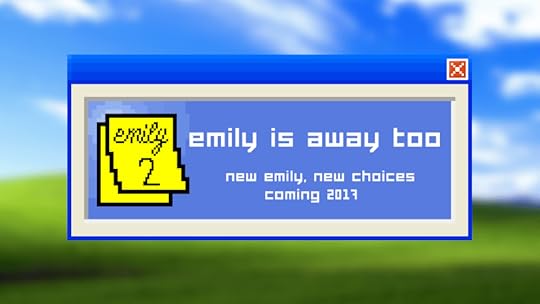
Like Emily Is Away, the new game will attempt to recreate the days of high school and college, the days before MySpace and Kazaa died. “But it’s definitely a different story,” Seeley said, with “true multiple ending support unlike the original.” You’ll be able to chat with Evelyn and Emily at the same time, with, I suspect, real strategy and intrigue. Ah, the days of “oops, wrong IM!”
Emily Is Away Too doesn’t have an exact release date just yet; Seeley’s only set a window of early 2017. However, you’ll want to start choosing your screen name and perfecting your profile quotes soon—this is what shapes your public persona, after all.
Follow Kyle Seeley on Twitter for Emily Is Away Too updates, or check out the official site. The original Emily Is Away is available for free on Steam.
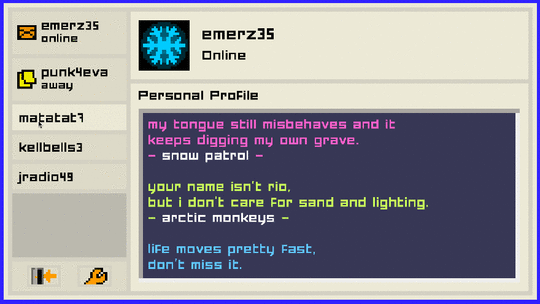
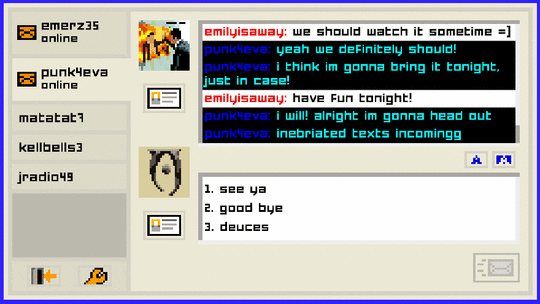
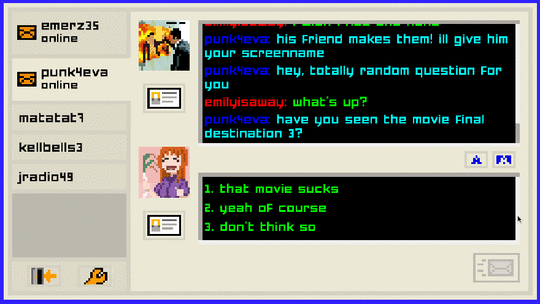
The post Start editing your away messages: Emily Is Away is getting a sequel appeared first on Kill Screen.
The 1990s, the decade that never ended
In 2013, the New Museum in New York presented an exhibition titled NYC 1993: Experimental Jet Set, Trash and No Star (named after an album by Sonic Youth). It curated art from the year of Bill Clinton’s inauguration. Soon after, New Jersey’s Montclair Art Museum featured Come As You Are: Art of the 1990s (named after a song by Nirvana). Jason Farago, writing about these shows for the BBC, posited that “this wave of 1990s shows marks a welcome effort to impose historical rigour on a period we still sometimes call ‘contemporary,’” but, “they reveal that the gap between then and now might not be as gaping as presupposed, and that, in aesthetic terms at least, the ‘90s are still going strong 15 years past their expiration date.”
That it’s challenging to identify a distinctly 90s aesthetic should be unsurprising for anybody whose formative years tracked the contours of the decade. When I was an adolescent in the 90s and beginning to think seriously about conforming to or opposing what I thought of as the mainstream, it felt as if the very concept of a mainstream meant less and less—after all, the biggest bands of the day, who acted as my moral barometer, performed what was called ‘alternative music.’ That’s because, during the 1990s, mainstream and alternative alike were subsumed into a voluminous, postmodern pastiche of information culled from across decades, made possible by the emergence of the internet in the home. Information grew like the feedback from a guitar and still resonates today, lasting precisely because it’s indistinct and impossible talk about in relation to a unified or defining ideology or principle. Imposing historical rigour upon the 90s, as those museum exhibits did, only contributes to its heteroglossic cacophony; the 1990s are the decade in which we stopped writing about history in terms of authors and decades.
transformed the notion of nostalgia
At the tail end of the 80s, a decade marked by Reagan’s nostalgia for a “shining city on a hill,” it felt as if the future was rushing towards us in the form of the 21st century. In 1990, when I was 10, Germany reunited, Nelson Mandela was freed, and the Hubble telescope was launched. Up until then, the sense had been that decades and presidents could serve as chapter headings in a compartmentalized experience of linear history. Then the internet arrived and blew those compartments up, fundamentally changing the way human beings communicate with one another.
My father worked in telecommunications, so my household was an early adopter of the internet. It was via the internet that my impressionable teen self was deluged with factual horrors to counterpoint Reagan and Bush I’s sepia-toned idealism. Two years into the decade we got the Bosnian Genocide, Rodney King riots, and Waco, Texas. Soon after came the Rwandan genocide. Francis Fukuyama’s The End of History and The Last Man (1992) codified his 1989 essay reifying American capitalism as the evolutionary end-point among right-wing political thinkers. The fall of the Soviet Union and the emergence of Bill Clinton’s New Democratic “Third Way” seemed to confirm Fukuyama’s thesis that laissez-faire capitalism was and always would be the ruling paradigm. When Clinton declared in his 1996 State of the Union address that, “The era of big government is over,” aspects of Fukuyama’s neo-Conservatism and Clinton’s neo-Liberalism became indistinguishable. Teens found themselves caught between the forces of their grandparents’ overweening nostalgia for a time long-gone, their parents’ 60s hippiedom turned into corporate pseudo-activism, and the sobering events of the world delivered through the exponential growth of internet use in the home. The effect was not that the 1990s could be tidily arranged alongside the decades that preceded it, but rather that the very notion of decades as coherent narratives with aesthetic tendencies was undermined.
In preparing for this article I thought about how I would summarize my experience of the aesthetic of the 90s, and the best I could come up with was “extreme”—a term that, in isolation, is so relative as to be meaningless. In comic books, the publisher Image launched, with its grittier line of amped-up violence and ultra-exaggerated anatomy. ‘Extreme sports’ entered our lexicon in order to market the X Games, and American Gladiators made what was once the stuff of dystopian cinema a reality. Shock jocks like Howard Stern rose to national prominence. Apple appropriated political and subcultural heroes for its “Think Different” campaign. In music, grunge and alternative implied a form of nihilism, both stubbornly unengaged (think Kurt Cobain’s stream-of-consciousness “a mulatto / an albino / a mosquito / my libido” approach to lyric-writing) and self-hating (think Kurt Cobain’s suicide), all while cycling through an intense loud-quiet-loud dynamic that emphasized volume through contrast. The 1990s did not have an aesthetic so much as a dynamic.
Turning to the videogames of the 1990s, they too can be seen to represent a paradoxical encapsulation of and departure from the norm. While their style often embodied as a rush towards the extreme, their mechanics and design suggest a golden age of invention: a space in which nuance and creativity were allowed to exist, where the subtlety of the player’s control over the game drew the player in. The 90s produced a shocking number of what we today consider canonical titles:
Super Mario World (1990)
Civilization (1991)
Street Fighter II (1991)
Sonic the Hedgehog (1991)
Mortal Kombat (1992)
The Legend of Zelda: A Link to the Past (1992)
Myst (1993)
Secret of Mana (1993)
Doom (1993)
NBA Jam (1993)
System Shock (1994)
Donkey Kong Country (1994)
EarthBound (1994)
Wipeout (1995)
Chrono Trigger (1995)
Super Mario 64 (1996)
Tomb Raider (1996)
Quake (1996)
Diablo (1996)
Resident Evil (1996)
Final Fantasy VII (1997)
GoldenEye 007 (1997)
The Legend of Zelda: Ocarina of Time (1998)
Half-Life (1998)
Metal Gear Solid (1998)
Tony Hawk’s Pro Skater (1999)
I mean, look at that list. Some of these games were the first of their genre, single-handedly inventing or advancing stealth mechanics (Metal Gear Solid), multiplayer shooters (GoldenEye 007), survival horror (Resident Evil), 2D fighters (Street Fighter II and Mortal Kombat) and physics-based puzzles (Half-Life). Some established a scope of story that had never before been encountered (Myst, Civilization, and Final Fantasy VII). When we talk about videogames in the 2010s, the games of the 1990s comprise the very vocabulary we use, because the way those games felt was both good and new.
it’s challenging to identify a distinctly 90s aesthetic
It helps, too, that these games still feel good when we play them today, be it Cape Mario’s swooping flight in Super Mario World or a perfectly-landed trick in Tony Hawk. While it’s possible to be nostalgic for some of the 8-bit classics of the 1980s, what usually happens upon playing them for longer than five minutes is a realization that they don’t conform to what we think of as a quality game today. They’re maddeningly hard, with steep learning curves, little to no direction or story, terrible physics, bad graphics, and are stubbornly unaccommodating. (What sadist invented the notion of three lives and zero continues?) But 1990s classics, on the other hand, are being ported to contemporary systems, finding new life on handhelds and emulator consoles.
What many of these titles had in common, and what made them children of the 90s, was their promise of more: more speed, more violence, a grander scope. Touchstones like Wipeout’s techno soundtrack, the vast number of hours required to finish Final Fantasy VII, the absurd size of Lara Croft’s bust, and Mortal Kombat’s fatalities seemed, to those of us in our middle teens, very adult. PlayStation arrived and introduced non-proprietary CD-ROM drives to the console market, not as a peripheral, but as the primary storage medium. The arms race that had begun as a battle between Nintendo’s Super Nintendo Entertainment System (SNES) and SEGA’s Genesis, which was catalogued in the 2014 book ‘Console Wars: Sega, Nintendo, and the Battle That Defined a Generation’, was utterly disrupted. The relatively immense storage capacity of CD-ROMs, combined with the fact that they were cheap to produce, allowed game makers to cram more and more into their games.
Despite this abundance, or perhaps because of it, for every classic game released in the 1990s there were about 10 knockoffs with bad commercial tie-ins and the same emphasis on being “extreme”: Duke Nukem 3D (1996); a plethora of 2D fighting games like Rise of the Robots (1994) and Shaq Fu (1994); almost everything involving The Simpsons; the inexplicable Phillips CD-i’s with licensed Nintendo properties, like Hotel Mario (1994) and the nightmare fuel Zelda series; and the ultraviolent Time Killers (1992) and Time Slaughter (1996), which suggested that the inevitable outcome of time travel will be fighters of every era hacking each other’s limbs off. The new possibilities opened up by CD media, combined with the newfound emphasis on excess, led to games whose fundamentals were not so much flawed as non-existent while their aesthetic flourishes were constant and seemingly unmoored from any kind of thematic unity. Simply put, the 1990s opened the floodgates.
Which is why it’s so difficult to talk about 90s aesthetics as something that can be defined, preserved, and subjected to the same kind of rebooting that we’ve become used to with every other decade. The 1990s did not produce a recognizable style so much as the feeling of abundance and an alienation from that feeling. Even subcultures that opposed mainstream commercialism, like grunge musicians, whose second-hand fashion implied an aversion to curated style, whose volume sought to deemphasize structure or coherence, and whose ironic mockery of authenticity or commitment to principles was meant to destabilize norms, were instantly subsumed, reduced to capital, and contributed to a monoculture of blooming, meaningless noise. In his 1993 essay “E Unibus Pluram: Television and U.S. Fiction,” David Foster Wallace wrote, “[…] today’s irony ends up saying: “How very banal to ask what I mean.” Anyone with the heretical gall to ask an ironist what he actually stands for ends up looking like a hysteric or a prig. And herein lies the oppressiveness of institutionalized irony, the too-successful rebel: the ability to interdict the question without attending to its content is tyranny. It is the new junta, using the very tool that exposed its enemy to insulate itself.”
the games of the 1990s comprise the very vocabulary we use
I return to the internet because it was a wide-angle lens on the ocean of information whose very abundance would defy anyone’s ability to impose a meaningful narrative framework. The internet fundamentally transformed the notion of nostalgia, hollowing out its utility and rendering the term almost meaningless. To be nostalgic is to retroactively impose a sincere and fond narrative on something, often with the implication that one is remembering it more fondly than it might have been in reality. In order for that to be true, it must be possible to over-value the thing. What the internet did, on the other hand, was allow a person to experience the thing again and again, at very little cost, and so it had the opposite effect of nostalgia: the internet devalues the thing by making it ubiquitous. For a teenager in the 1990s, it can’t be overstated how the abundance and repetition of experience had the effect of reducing that experience’s impact.
The culmination of the 1990’s confused rush towards the extreme was Woodstock ‘99. A person can go on and on about the original Woodstock as a singular event in the chronology of the 60s counterculture because, whether it really was as significant as they’re making it out to be or not, it only occurred once, allowing a person to thereafter be nostalgic about it. The original Woodstock serves as a fixed reference point for myriad takes on what it meant. My generation’s Woodstock, on the other hand, was a prepackaged, heavily commercialized attempt to recycle the singular cultural occurrence of a major music festival – except with a more extreme attitude. The lineup included a series of ‘nu metal’ acts, the apotheosis of grunge’s adolescent, directionless anger, who seemed to rage at the idea of the festival itself. It ended with rape and violence; I watched from a couch in my friend’s basement as Fred Durst of Limp Bizkit egged the crowd on and fires began to spring up in the background. Woodstock ‘99 was 200,000 people, at the dawn of the new millennium, carrying out a kind of protest against the very thing they were gathered to observe, not to celebrate love in the spirit of counterculturalism, but to give money to a soulless corporate contrivance for the right to break that contrivance in protest of the fact that the whole affair was utterly meaningless. If there was any kind of recognizable ideology present, it was the depressingly inter-generational ideology of men imposing their will upon women.
Photo by Frank Micelotta/ImageDirect
When it comes to the insatiable need to revisit commercial properties for another profitable round, the 1990s presents a tricky proposition. Simply put, it was a dark time. The cultural figures of the day didn’t have much to say, and those who tried were immediately appropriated into a kind of featureless, commercial heteroglossia. It’s only appropriate that David Foster Wallace’s Infinite Jest (1996), a hyper-detailed tome of a novel, would also appear in the 90s. Its story features a medium without distinct content and without end, which renders its viewers incapacitated and disinterested in anything else. The 1990s were the decade in which the concept of an American monoculture crested and disappeared into the postmodern beyond. Everything was accessible, at full volume, for money, and this crassness and crudeness made it subject to endless irony—infinite jest, indeed. I pity the poor souls who try to build a marketing campaign around that.
Header Image provided by Colin Morris on Flickr.
The post The 1990s, the decade that never ended appeared first on Kill Screen.
October 17, 2016
Knotting into Dishonored’s decaying city
Heterotopias is a series of visual investigations into virtual spaces performed by artist and writer Gareth Damian Martin.
///
There is no such thing as a total vision of a city. Statistics, guidebooks, politicians, newspapers, tourists, maps, and surveys like to suggest otherwise, but theirs is a constricted world, an incomplete image. Those of us who live in cities know very well of their tendency to conceal and reveal themselves with unexpected rhythms, as if at random—surprising us with new configurations and revelations, shifting prism-like with the passing of time or the changing of the light. Perhaps that’s why the most alluring virtual cities are those that remain tellingly incomplete. The ones that don’t allow us to endlessly scramble across every rooftop and spire, every alley and basement, from outskirts to heartland and back again. The ones that don’t get hollowed out through the ceaseless pursuit of side missions and collectibles, trinkets and trash.
Dunwall is one such city. And as a well known, and often mentioned entry in the lists of fictional videogame cities, it is easy to forget how little of it we have actually seen. Returning to Dishonored (2012) now, only a week or so after its fourth anniversary, we find little more than a handful of locations, maybe 20 streets or so, broken up with towering landmarks and their labyrinthine interiors. We find an artful collection of virtual masonry, mostly emptied of its citizens, arranged in precise corridors around a wide, grubby river. We find fragments of its stories, a collection of evocative texts that hint at histories and folklore, songs and systems. We find the implication of a city, little more than the suggestion of its parts, told from behind a single set of eyes.
Cobblestones are shrouded with dust and dirt
And yet, Dunwall feels vast. Perhaps it is because of the Wrenhaven River, which remains ever present, forming your path in and out of the various districts. There is something about rivers that coheres cities, that give their huge unwieldy forms a sense of direction, a focal point. For Dunwall, the river also provides an overlook, a chance to spot the crowded shores of the opposite bank, to see the city at a distance, inaccessible, but ever present. In this sense, Dunwall replicates that feeling of exploring a real city, the knowledge that much of it is out of your reach, more often imagined than visited, reduced to daydreams, borrowed images, and the dull glint of a thousand roof tiles. Arkane’s choice to structure the game around the Wrenhaven river feels like an attempt to provide some distance, some contrast with the claustrophobia that emerges on every descent into those overwhelming streets.
It’s the detail, the layering, that makes the alleys and thoroughfares of Dunwall so impactful. Many games write histories for their cities, coming up with fictional pasts, long-dead rulers, wars and struggles. But few write those histories into the very stone of their buildings. Dishonored relies on a many-leveled strata of decay and development to tell the stories of its city as much as any piece of lore or dialog. Old brick gives way to white stone, which is augmented with rain-stained steel. Cobblestones are shrouded with dust and dirt, then decorated by a patina of moss and pulped paper. Carpets are shunted into bumps and worn down at their center by insistent feet. Metal casings are nailed onto old facades to carry the wires and pipes of new technology. Even the river seems to be eager to swallow the city up, to coat it in barnacles and mossy green growth. That perhaps is the fate of all river cities: to eventually be eaten by the waterway that sustains them. If so, then Dunwall is a diagram of this precisely observed process, and of the stories time tells in steel and stone. One that I have made an extensive, yet unsurprisingly incomplete, attempt to document.
These images begin, for me, to eke out a description of Dunwall. It is a description reliant on Dunwall’s real world references, namely the cities of London and Edinburgh. Dishonored presents a kind of grim fantasy of both these places, not the utopia they aspire towards, but the dystopia their dysfunctions suggest. In my revisiting of Dunwall I found myself reminded of Thomas Pynchon’s darkly romantic description of London under siege by the blitz in Gravity’s Rainbow (1973). Dunwall seems to reflect what Pynchon called London’s “iron afternoons,” where he describes “the yellow sun being teased apart by a thousand chimneys breathing, fawning upward without shame. This smoke is more than the day’s breath, more than dark strength—it is an imperial presence that lives and moves.” And as I picked my way through the carefully designed corridors I was reminded of the opening description of Gravity’s Rainbow and its shattered, decaying London:
“No, this is not a disentanglement from, but a progressive knotting into—they go in under archways, secret entrances of rotted concrete that only looked like loops of an underpass . . . certain trestles of blackened wood have moved slowly by overhead, and the smells begun of coal from days far to the past, smells of naphtha winters, of Sundays when no traffic came through, of the coral-like and mysteriously vital growth, around the blind curves and out the lonely spurs, a sour smell of rolling-stock absence, of maturing rust, developing through those emptying days brilliant and deep, especially at dawn, with blue shadows to seal its passage, to try to bring events to Absolute Zero . . . and it is poorer the deeper they go . . . ruinous secret cities of poor, places whose names he has never heard . . . the walls break down, the roofs get fewer and so do the chances for light. The road, which ought to be opening out into a broader highway, instead has been getting narrower, more broken, cornering tighter and tighter until all at once, much too soon, they are under the final arch brakes grab and spring terribly. It is a judgement from which there is no appeal.”
This passage evokes the process of becoming “knotted into” Dunwall, of discovering each layer of its stained and broken form. The above is not so much an accurate picture of London as it is a fever dream, a collection of textures and atmospheres aligned to suggest some kind of terrifying whole. Like Pynchon, with Dishonored Arkane sketched their own fever dream of London, their own set of textures and atmospheres that both reflected that great city and abstracted a series of images from it.
these depthless virtual characters appear to be weather-worn
I found people too, among all this decay, often warming their hands by the fire, or smoking cigarettes to warm their arching bones. Not many, not even enough to fill the modest streets on offer, but people all the same. In fact, in their minority they seem more particular than the thronging crowds that often populate virtual cities, more linked to the streets they wander. Their clothes, their hands, their faces seem to carry the same sense of layering, the same distortions of time in their cracked and sullied forms. It’s a powerful trick, to make these depthless virtual characters appear to be weather-worn, aged, and it’s one that much of Dishonored‘s lasting power hangs on.
In capturing their portraits it was this worn quality, along with their symbiotic link to those decaying streets, that I wanted to show. They are a ragged selection; some dead some dying, but each one seems, in their own way, to reflect some aspect of Dunwall, from its grimy shores to its lavish heights.
Yet none of these seem to offer a true portrait of this fictional city—for that I had to move closer. The views of distant rooftops and towering buildings seemed excessive, distracted from the truth of this place, and the portraits were too colored by character, by a single perspective. Dunwall, after all, comes to life not as a set of vistas, or viewpoints, but a series of intimate tableaux. In corners and stairwells, among the carefully arranged rooms and corridors I found still lifes: collections of furniture, technology, masonry, and architecture that seemed to get at the heart of Dunwall. Like Pynchon’s descriptions, which are defined by their knotty nature and their absences or obscurities as much as their inclusions, these became attempts to describe a city in a single fragment alone.
From Dunwall, these images draw a sense of decay, death, inequality, luxury, processes of time and erosion, qualities of light. All the incomplete things that make Dishonored‘s city and its precisely crafted depiction, not just a great fictional city, but a city profoundly in communion with the cities it reflects, that even now we live among and beside. Not a total vision, but an array of fragments that might guide your idle daydreams.
The post Knotting into Dishonored’s decaying city appeared first on Kill Screen.
Kill Screen Magazine's Blog
- Kill Screen Magazine's profile
- 4 followers












